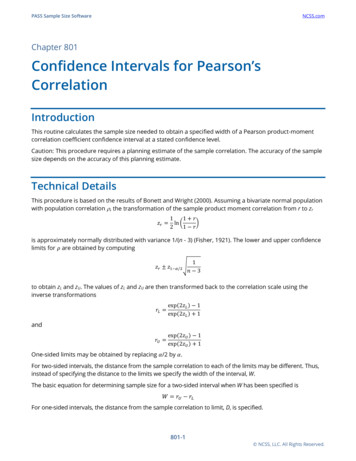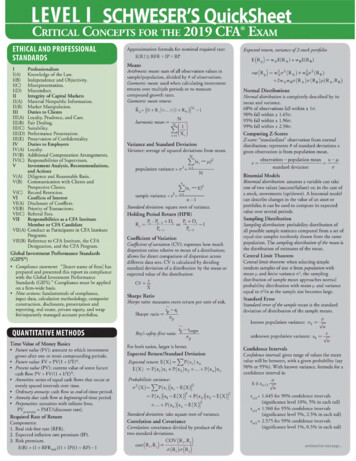
Transcription
PASS Sample Size SoftwareNCSS.comChapter 801Confidence Intervals for Pearson’sCorrelationIntroductionThis routine calculates the sample size needed to obtain a specified width of a Pearson product-momentcorrelation coefficient confidence interval at a stated confidence level.Caution: This procedure requires a planning estimate of the sample correlation. The accuracy of the samplesize depends on the accuracy of this planning estimate.Technical DetailsThis procedure is based on the results of Bonett and Wright (2000). Assuming a bivariate normal populationwith population correlation ρ, the transformation of the sample product moment correlation from r to zr11 𝑟𝑟 𝑧𝑧𝑟𝑟 ln 21 𝑟𝑟is approximately normally distributed with variance 1/(n - 3) (Fisher, 1921). The lower and upper confidencelimits for 𝜌𝜌 are obtained by computing𝑧𝑧𝑟𝑟 𝑧𝑧1 𝛼𝛼/2 1𝑛𝑛 3to obtain zL and zU. The values of zL and zU are then transformed back to the correlation scale using theinverse transformationsand𝑟𝑟𝐿𝐿 exp(2𝑧𝑧𝐿𝐿 ) 1exp(2𝑧𝑧𝐿𝐿 ) 1𝑟𝑟𝑈𝑈 exp(2𝑧𝑧𝑈𝑈 ) 1exp(2𝑧𝑧𝑈𝑈 ) 1One-sided limits may be obtained by replacing 𝛼𝛼/2 by 𝛼𝛼.For two-sided intervals, the distance from the sample correlation to each of the limits may be different. Thus,instead of specifying the distance to the limits we specify the width of the interval, W.The basic equation for determining sample size for a two-sided interval when W has been specified is𝑊𝑊 𝑟𝑟𝑈𝑈 𝑟𝑟𝐿𝐿For one-sided intervals, the distance from the sample correlation to limit, D, is specified.801-1 NCSS, LLC. All Rights Reserved.
PASS Sample Size SoftwareNCSS.comConfidence Intervals for Pearson’s CorrelationThe basic equation for determining sample size for a one-sided upper limit when D has been specified is𝐷𝐷 𝑟𝑟𝑈𝑈 𝑟𝑟The basic equation for determining sample size for a one-sided lower limit when D has been specified is𝐷𝐷 𝑟𝑟 𝑟𝑟𝐿𝐿Each of these equations can be solved for any of the unknown quantities in terms of the others.Confidence LevelThe confidence level, 1 – 𝛼𝛼, has the following interpretation. If thousands of samples of n items are drawn froma population using simple random sampling and a confidence interval is calculated for each sample, theproportion of those intervals that will include the true population correlation is 1 – 𝛼𝛼.801-2 NCSS, LLC. All Rights Reserved.
PASS Sample Size SoftwareNCSS.comConfidence Intervals for Pearson’s CorrelationExample 1 – Calculating Sample SizeSuppose a study is planned in which the researcher wishes to construct a two-sided 95% confidence intervalfor the population Pearson correlation such that the width of the interval is no wider than 0.08. Theresearcher would like to examine a large range of sample correlation values to determine the effect of thecorrelation estimate on necessary sample size. Instead of examining only the interval width of 0.08, widthsof 0.06 and 0.10 will also be considered.The goal is to determine the necessary sample size.SetupIf the procedure window is not already open, use the PASS Home window to open it. The parameters for thisexample are listed below and are stored in the Example 1 settings file. To load these settings to theprocedure window, click Open Example Settings File in the Help Center or File menu.Design TabSolve For . Sample SizeInterval Type . Two-SidedConfidence Level (1 – Alpha). 0.95Confidence Interval Width (Two-Sided) . 0.06 0.08 0.10r (Sample Correlation). -0.9 to 0.9 by 0.1OutputClick the Calculate button to perform the calculations and generate the following output.Numeric ReportsNumeric Results for Two-Sided Confidence Intervals for Pearson Correlation Solve For: Sample Size elationLowerUpperWidth ifLevelNWidthWidthrLimitLimitr 0.0 0600.0610.0620.066801-3 NCSS, LLC. All Rights Reserved.
PASS Sample Size SoftwareNCSS.comConfidence Intervals for Pearson’s 440.2740.95620.100.100.90.8390.9390.500 Confidence LevelNWidthTarget WidthActual WidthrLower and Upper LimitWidth if r 0.0The proportion of confidence intervals (constructed with this same confidence level, sample size,etc.) that would contain the true correlation.The size of the sample drawn from the population.The distance from the lower limit to the upper limit.The value of the width that is entered into the procedure.The value of the width that is obtained from the procedure.The estimate of Pearson's product moment correlation coefficient.The lower and upper limits of the confidence interval.The maximum width for a confidence interval with sample size N.Summary Statements A sample size of 161 produces a two-sided 95% confidence interval with a width equal to 0.06 when the estimateof Pearson's product-moment correlation is -0.9. 801-4 NCSS, LLC. All Rights Reserved.
PASS Sample Size SoftwareNCSS.comConfidence Intervals for Pearson’s CorrelationDropout-Inflated Sample Size DropoutInflatedExpectedEnrollmentNumber ofSample SizeSample SizeDropoutsDropout RateNN'D 7801-5 NCSS, LLC. All Rights Reserved.
PASS Sample Size SoftwareNCSS.comConfidence Intervals for Pearson’s 27816 Dropout RateNN'DThe percentage of subjects (or items) that are expected to be lost at random during the course of the studyand for whom no response data will be collected (i.e., will be treated as "missing"). Abbreviated as DR.The evaluable sample size at which the confidence interval is computed. If N subjects are evaluated out ofthe N' subjects that are enrolled in the study, the design will achieve the stated confidence interval.The total number of subjects that should be enrolled in the study in order to obtain N evaluable subjects,based on the assumed dropout rate. After solving for N, N' is calculated by inflating N using the formula N' N / (1 - DR), with N' always rounded up. (See Julious, S.A. (2010) pages 52-53, or Chow, S.C., Shao, J.,Wang, H., and Lokhnygina, Y. (2018) pages 32-33.)The expected number of dropouts. D N' - N.Dropout Summary Statements Anticipating a 20% dropout rate, 202 subjects should be enrolled to obtain a final sample size of 161 subjects. References Bonett, D. G. and Wright, T. A. 2000. 'Sample Size Requirements for Estimating Pearson, Kendall and SpearmanCorrelations.' Psychometrika, Vol 65, No 1 (March), 23-28.Looney, S. W. 1996. 'Sample size determination for correlation coefficient inference: Practical problems andpractical solutions.' American Statistical Association 1996 Proceedings of the Section on Statistical Education,240-245.Cook, R. D. and Weisburg, S. 1999. Applied Regression Including Computing and Graphics. John Wiley and Sons,Inc.Ostle, B. and Malone, L.C. 1988. Statistics in Research. Iowa State University Press. Ames, Iowa.Zar, J. H. 1984. Biostatistical Analysis. Second Edition. Prentice-Hall. Englewood Cliffs, New Jersey.Fisher, R. A. 1921. 'On the probable error of a coefficient of correlation deduced from a small sample.' Metron, i (4),1-32. This report shows the calculated sample size for each of the scenarios.801-6 NCSS, LLC. All Rights Reserved.
PASS Sample Size SoftwareNCSS.comConfidence Intervals for Pearson’s CorrelationPlots SectionPlots These plots show the sample size versus the sample correlation for the three confidence interval widths.801-7 NCSS, LLC. All Rights Reserved.
PASS Sample Size SoftwareNCSS.comConfidence Intervals for Pearson’s CorrelationExample 2 – Validation using Bonett and Wright (2000)Bonett and Wright (2000), page 26, give an extensive table of sample sizes for two-sided confidence intervalsfor Pearson correlations when the confidence levels are 95% and 99%. When the sample correlation is 0.3and the interval width is 0.2, they obtain sample sizes of 320 and 550, respectively.Note that we checked our results with this table and found a few differences which are obvious typos.SetupIf the procedure window is not already open, use the PASS Home window to open it. The parameters for thisexample are listed below and are stored in the Example 2 settings file. To load these settings to theprocedure window, click Open Example Settings File in the Help Center or File menu.Design TabSolve For . Sample SizeInterval Type . Two-SidedConfidence Level (1 – Alpha). 0.95 0.99Confidence Interval Width (Two-Sided) . 0.2r (Sample Correlation). 0.3OutputClick the Calculate button to perform the calculations and generate the following output.Numeric Results for Two-Sided Confidence Intervals for Pearson Correlation Solve For: Sample Size elationLowerUpperWidth ifLevelNWidthWidthrLimitLimitr 0.0 970.3970.219 PASS also calculated the sample sizes to be 320 and 550.801-8 NCSS, LLC. All Rights Reserved.
Confidence Intervals for Pearson's Correlation - NCSS . pass










